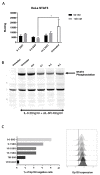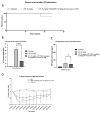Modulation of Pro-Inflammatory IL-6 Trans-Signaling Axis by Splice Switching Oligonucleotides as a Therapeutic Modality in Inflammation
- PMID: 37759507
- PMCID: PMC10526877
- DOI: 10.3390/cells12182285
Modulation of Pro-Inflammatory IL-6 Trans-Signaling Axis by Splice Switching Oligonucleotides as a Therapeutic Modality in Inflammation
Abstract
Interleukin-6 (IL-6) is a pleiotropic cytokine that plays a crucial role in maintaining normal homeostatic processes under the pathogenesis of various inflammatory and autoimmune diseases. This context-dependent effect from a cytokine is due to two distinctive forms of signaling: cis-signaling and trans-signaling. IL-6 cis-signaling involves binding IL-6 to the membrane-bound IL-6 receptor and Glycoprotein 130 (GP130) signal-transducing subunit. By contrast, in IL-6 trans-signaling, complexes of IL-6 and the soluble form of the IL-6 receptor (sIL-6R) signal via membrane-bound GP130. Various strategies have been employed in the past decade to target the pro-inflammatory effect of IL-6 in numerous inflammatory disorders. However, their development has been hindered since these approaches generally target global IL-6 signaling, also affecting the anti-inflammatory effects of IL-6 signaling too. Therefore, novel strategies explicitly targeting the pro-inflammatory IL-6 trans-signaling without affecting the IL-6 cis-signaling are required and carry immense therapeutic potential. Here, we have developed a novel approach to specifically decoy IL-6-mediated trans-signaling by modulating alternative splicing in GP130, an IL-6 signal transducer, by employing splice switching oligonucleotides (SSO), to induce the expression of truncated soluble isoforms of the protein GP130. This isoform is devoid of signaling domains but allows for specifically sequestering the IL-6/sIL-6R receptor complex with high affinity in serum and thereby suppressing inflammation. Using the state-of-the-art Pip6a cell-penetrating peptide conjugated to PMO-based SSO targeting GP130 for efficient in vivo delivery, reduced disease phenotypes in two different inflammatory mouse models of systemic and intestinal inflammation were observed. Overall, this novel gene therapy platform holds great potential as a refined therapeutic intervention for chronic inflammatory diseases.
Keywords: IL-6 trans-signaling; inflammation; nucleic acid therapies; oligonucleotides.
Conflict of interest statement
The authors declare no conflict of interest.
Figures






Similar articles
-
Interleukin-6 biology is coordinated by membrane-bound and soluble receptors: role in inflammation and cancer.J Leukoc Biol. 2006 Aug;80(2):227-36. doi: 10.1189/jlb.1105674. Epub 2006 May 17. J Leukoc Biol. 2006. PMID: 16707558 Review.
-
The balance of interleukin (IL)-6, IL-6·soluble IL-6 receptor (sIL-6R), and IL-6·sIL-6R·sgp130 complexes allows simultaneous classic and trans-signaling.J Biol Chem. 2018 May 4;293(18):6762-6775. doi: 10.1074/jbc.RA117.001163. Epub 2018 Mar 20. J Biol Chem. 2018. PMID: 29559558 Free PMC article.
-
A soluble form of the interleukin-6 family signal transducer gp130 is dimerized via a C-terminal disulfide bridge resulting from alternative mRNA splicing.Biochem Biophys Res Commun. 2016 Feb 19;470(4):870-6. doi: 10.1016/j.bbrc.2016.01.127. Epub 2016 Jan 22. Biochem Biophys Res Commun. 2016. PMID: 26809098
-
Structure-guided optimization of the interleukin-6 trans-signaling antagonist sgp130.J Biol Chem. 2008 Oct 3;283(40):27200-7. doi: 10.1074/jbc.M803694200. Epub 2008 Jul 23. J Biol Chem. 2008. PMID: 18650419
-
Interleukin-6 and its receptors: a highly regulated and dynamic system.Cytokine. 2014 Nov;70(1):11-20. doi: 10.1016/j.cyto.2014.05.024. Epub 2014 Jun 28. Cytokine. 2014. PMID: 24986424 Review.
Cited by
-
Protein isoform-centric therapeutics: expanding targets and increasing specificity.Nat Rev Drug Discov. 2024 Oct;23(10):759-779. doi: 10.1038/s41573-024-01025-z. Epub 2024 Sep 4. Nat Rev Drug Discov. 2024. PMID: 39232238 Review.
-
The impact of interleukin-6 (IL-6) and mesenchymal stem cell-derived IL-6 on neurological conditions.Front Immunol. 2024 Jun 24;15:1400533. doi: 10.3389/fimmu.2024.1400533. eCollection 2024. Front Immunol. 2024. PMID: 39015561 Free PMC article. Review.
-
uORF-targeting steric block antisense oligonucleotides do not reproducibly increase RNASEH1 expression.Mol Ther Nucleic Acids. 2024 Nov 28;36(1):102406. doi: 10.1016/j.omtn.2024.102406. eCollection 2025 Mar 11. Mol Ther Nucleic Acids. 2024. PMID: 39759875 Free PMC article.
-
Diabetic Retinopathy: New Treatment Approaches Targeting Redox and Immune Mechanisms.Antioxidants (Basel). 2024 May 12;13(5):594. doi: 10.3390/antiox13050594. Antioxidants (Basel). 2024. PMID: 38790699 Free PMC article. Review.
References
-
- Kamimura D., Arima Y., Hirano T., Ogura H., Murakami M. Cytokine Frontiers. Springer; Berlin/Heidelberg, Germany: 2014. - DOI
-
- Hirano T. Interleukin 6 in autoimmune and inflammatory diseases: A personal memoir. [(accessed on 19 May 2015)];Proc. Jpn. Acad. Ser. B Phys. Biol. Sci. 2010 86:717–730. doi: 10.2183/pjab.86.717. Available online: http://www.pubmedcentral.nih.gov/articlerender.fcgi?artid=3066534&tool=p.... - DOI - PMC - PubMed
Publication types
MeSH terms
Substances
LinkOut - more resources
Full Text Sources
Miscellaneous

